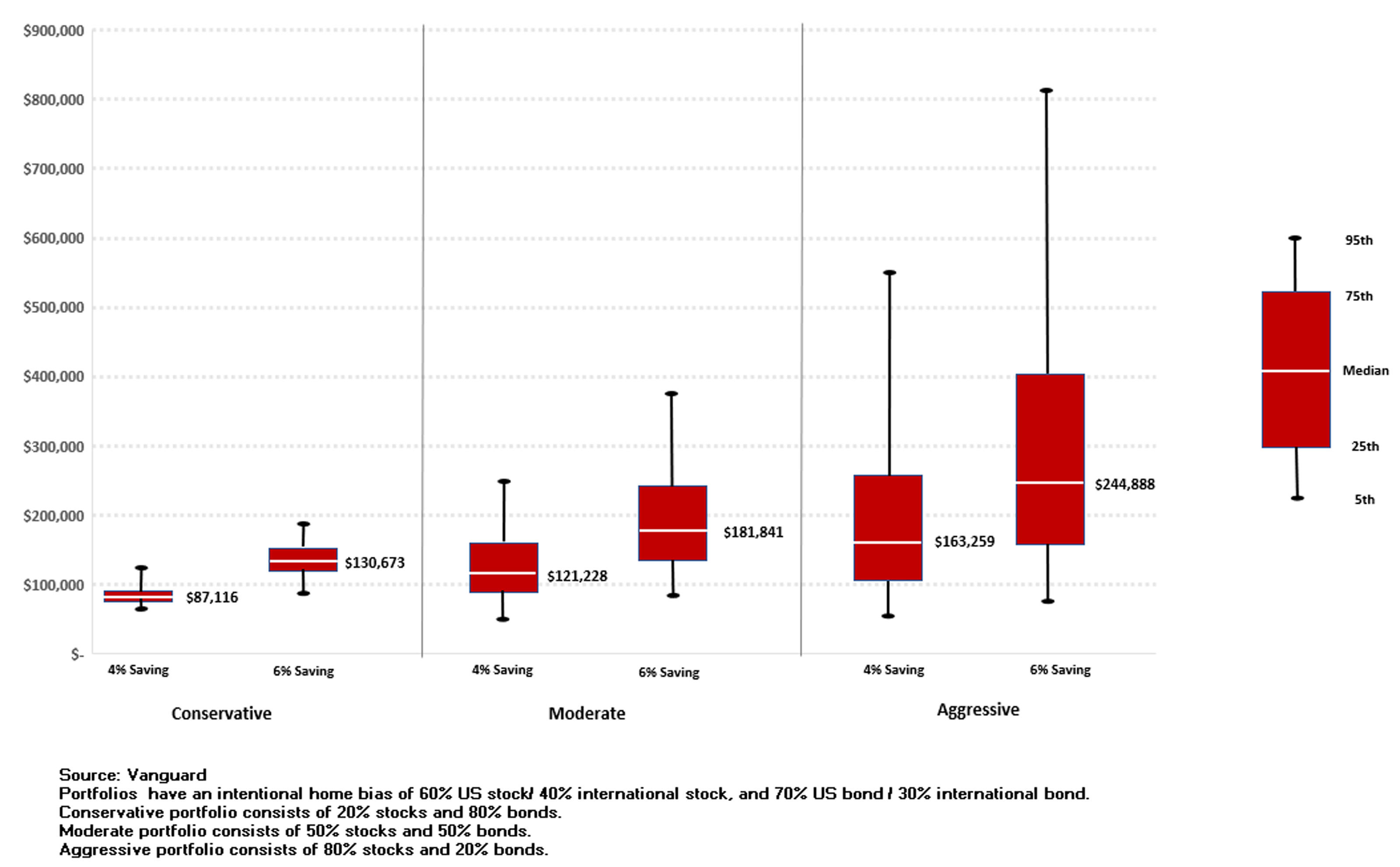Investor Success: Measure in Dollars, not (Per)Cents
You can’t control the markets, but a big part of your success in investing for retirement is entirely in your own hands.


The concept of “investing success,” as it often appears in the media, is a tangled web to me. Every time I read something about the topic, I can’t help but feel that the authors are confusing two very different efforts: investment success and investor success.
Yes, this is nuanced, but yes, it matters. Too often, investment success is defined in either absolute or relative returns (which is another nuance for another time). While I understand why a portfolio manager would focus on higher returns, I’d argue that this shouldn’t be the benchmark for success for the typical investor. Instead, they should be focused on building the wealth they need to fulfill the objectives that matter most to them. Wealth is measured in dollars, not percents.
Your Savings Rate Is a Huge Factor in Your Success as an Investor
Sure, better returns build more wealth faster, but higher returns are not essential to building wealth. Investing is a partnership between an investor and the markets, where an investor provides the capital and the markets provide the prospects for a return on that capital. Understanding this relationship introduces a most important point for building wealth — capital contributions.
From just $107.88 $24.99 for Kiplinger Personal Finance
Become a smarter, better informed investor. Subscribe from just $107.88 $24.99, plus get up to 4 Special Issues

Sign up for Kiplinger’s Free Newsletters
Profit and prosper with the best of expert advice on investing, taxes, retirement, personal finance and more - straight to your e-mail.
Profit and prosper with the best of expert advice - straight to your e-mail.
A portfolio’s value can grow through both capital contributions and the return on capital, but only one part of this equation can grow wealth reliably: our capital contributions, or more generally, our savings. It’s our contribution to our own investment success and importantly, unlike the investment returns we seek, its benefits are both more certain and within our control.
Contributing More to Savings vs. Taking More Risk
As illustrated in the figure below, moving from a more conservative asset allocation (50% stocks/50% bonds) to a more aggressive one (80% stocks/20% bonds) tends to widen the range of expected outcomes. At any asset allocation choice, higher savings levels contribute to higher best, worst, and median expected outcomes, due to the higher levels of capital contributions.
What is often overlooked, however, is that higher levels of capital contributions allow investors to improve their expected outcomes not only relative to the same asset allocation, but also relative to a higher risk allocation. For example, for the 50% stocks/50% bonds portfolio, a 6% contribution rate provides a better range of total potential outcomes than a 4% savings rate for the same asset allocation and for the majority of expected outcomes in even riskier allocations.

Higher returns are welcomed, but they are a less reliable source of asset growth and wealth creation.
A most extreme version of this scenario played itself out on the national stage when the Powerball lottery offered a $1 billion-plus jackpot. While the lottery gave a player a chance for a fabulous return on their $2 ticket, probability-wise, a player’s wealth would increase more certainly if they didn’t play the lottery at all (since they’re most likely to lose their whole “investment” in lottery tickets).
The Bottom Line for Investors
Investing involves tradeoffs, and an important part of the financial planning process is for an investor to define their willingness to forgo spending now to improve their prospects for building wealth that can provide for their future needs. This is critically important, as a higher savings rate provides a higher probability of investor success. This is due to the partial shift in responsibility for building wealth from the less certain returns from risky assets to a more certain stream of capital contributions.
In the end, if an investor is trying to maximize future wealth, we believe a marginally higher savings rate, rather than a substantially higher risk portfolio, will be more likely to lead to investor success.
Profit and prosper with the best of Kiplinger's advice on investing, taxes, retirement, personal finance and much more. Delivered daily. Enter your email in the box and click Sign Me Up.

Don Bennyhoff, CFA®, serves as the Chairman of the Investment Committee and Director of Investor Education at Liberty Wealth Advisors, a $1.7B RIA. An industry expert who spent over 22 years at The Vanguard Group, Don was a Founding Member of Vanguard’s Investment Strategy Group, and served as a Senior Investment Strategist.
-
 Forget FIRE: Why ‘FILE’ Is the Smarter Move for Child-Free DINKs
Forget FIRE: Why ‘FILE’ Is the Smarter Move for Child-Free DINKsHow shifting from "Retiring Early" to "Living Early" allows child-free adults to enjoy their wealth while they’re still young enough to use it.
-
 7 Tax Blunders to Avoid in Your First Year of Retirement
7 Tax Blunders to Avoid in Your First Year of RetirementA business-as-usual approach to taxes in the first year of retirement can lead to silly trip-ups that erode your nest egg. Here are seven common goofs to avoid.
-
 How to Plan for Social Security in 2026's Changing Landscape
How to Plan for Social Security in 2026's Changing LandscapeNot understanding how the upcoming changes in 2026 might affect you could put your financial security in retirement at risk. This is what you need to know.
-
 7 Tax Blunders to Avoid in Your First Year of Retirement, From a Seasoned Financial Planner
7 Tax Blunders to Avoid in Your First Year of Retirement, From a Seasoned Financial PlannerA business-as-usual approach to taxes in the first year of retirement can lead to silly trip-ups that erode your nest egg. Here are seven common goofs to avoid.
-
 How to Plan for Social Security in 2026's Changing Landscape, From a Financial Professional
How to Plan for Social Security in 2026's Changing Landscape, From a Financial ProfessionalNot understanding how the upcoming changes in 2026 might affect you could put your financial security in retirement at risk. This is what you need to know.
-
 6 Overlooked Areas That Can Make or Break Your Retirement, From a Retirement Adviser
6 Overlooked Areas That Can Make or Break Your Retirement, From a Retirement AdviserIf you're heading into retirement with scattered and uncertain plans, distilling them into these six areas can ensure you thrive in later life.
-
 I'm a Wealth Adviser: These Are the 7 Risks Your Retirement Plan Should Address
I'm a Wealth Adviser: These Are the 7 Risks Your Retirement Plan Should AddressYour retirement needs to be able to withstand several major threats, including inflation, longevity, long-term care costs, market swings and more.
-
 High-Net-Worth Retirees: Don't Overlook These Benefits of Social Security
High-Net-Worth Retirees: Don't Overlook These Benefits of Social SecurityWealthy retirees often overlook Social Security. But timed properly, it can drive tax efficiency, keep Medicare costs in check and strengthen your legacy.
-
 Do You Have an Insurance Coverage Gap for Your Valuables? You May Be Surprised to Learn You Do
Do You Have an Insurance Coverage Gap for Your Valuables? You May Be Surprised to Learn You DoStandard homeowners insurance usually has strict limits on high-value items, so you should formally "schedule" these valuable possessions with your insurer.
-
 8 Practical Ways to Declutter Your Life in 2026: A Retirement 'Non-Resolution' Checklist
8 Practical Ways to Declutter Your Life in 2026: A Retirement 'Non-Resolution' ChecklistHere's how to stop wasting your energy on things that don't enhance your new chapter and focus on the things that do.
-
 To Retire Rich, Stop Chasing Huge Returns and Do This Instead, Courtesy of a Financial Planner
To Retire Rich, Stop Chasing Huge Returns and Do This Instead, Courtesy of a Financial PlannerSaving a large percentage of your income, minimizing taxes and keeping spending in check can offer a more realistic path to retiring rich.